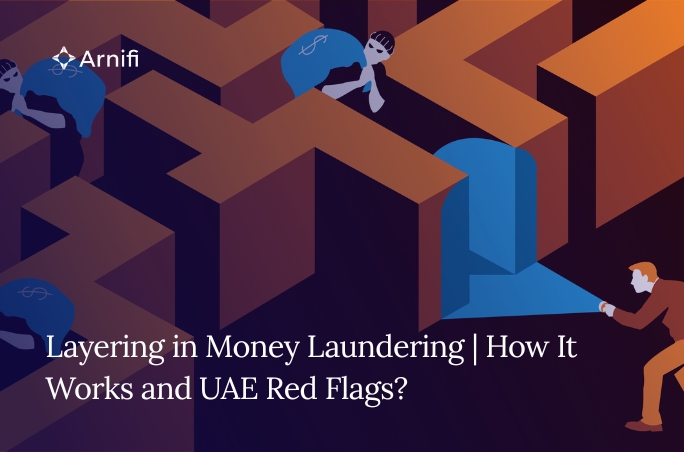Layering in Money Laundering | How It Works and UAE Red Flags?
by
Shethana
Nov 27, 2025  7 MIN READ
7 MIN READ

Money laundering is the process of taking money that comes from crime and making it look like clean business income.
International bodies usually break it into three stages. First is placement, when illicit cash first enters the financial system. Second is layering, when the trail is hidden. Third is integration, when the funds return to the criminal as apparently legal money.
UAE law treats money laundering as a separate crime on top of the original offence. Federal Decree Law No. 20 of 2018 sets out the main rules. It defines money laundering and requires strong controls against it.
What Is Layering in Money Laundering?
Layering is the middle stage of the laundering cycle. It comes after placement, once illicit funds have already entered a bank, exchange house or other channel.
Global guidance describes layering as a set of transactions designed to disguise the origin of money so that the link to the underlying crime becomes hard to see. In practice, this means moving value through many accounts, products, and sometimes countries, until the audit trail is blurred.
Layering adds “successive layers of legitimacy” to funds until their source is obscured from authorities. For compliance teams in the UAE, this stage is often the hardest to detect because each individual payment can look ordinary when seen alone.
How Layering Typically Works (Without the Criminal Detail)
Public material on financial crime shows several broad patterns in layering activity. These patterns help firms understand risk without giving operational “how-to” detail.
- Funds are moved through frequent transfers between related personal accounts, shell companies, and trusts, often with no clear business reason.
- Transactions may be split into many smaller amounts to avoid internal alerts or regulatory thresholds, a tactic often called structuring.
- Complex trade flows, over- or under-invoicing, or repeated advance payments can also be used to shift value between jurisdictions.
- In newer cases, investigators see rapid movement between bank accounts, prepaid cards and virtual asset service providers, sometimes across several countries in a short time.
The key feature is not one specific product. It is the overall pattern: many movements, weak economic purpose, and a clear attempt to distance funds from their criminal starting point.
UAE AML Framework and Why Layering Matters
The UAE’s AML framework combines federal law, cabinet decisions and guidance from sector regulators. Federal Decree-Law No. 20 of 2018 and its implementing regulations set the base obligations on customer due diligence, ongoing monitoring and reporting of suspicious activities.
The Central Bank of the UAE supervises licensed financial institutions and runs a dedicated Anti-Money Laundering Department to assess risks, carry out inspections and impose penalties when firms fall short. Guidance documents for banks and cash-intensive businesses stress that customer risk assessment and transaction monitoring must take account of how money can be layered across products and borders.
The national AML/CFT strategy, overseen by a federal committee and supported by the UAE Financial Intelligence Unit (FIU), expects firms to file suspicious transaction reports when patterns suggest possible layering, even if the underlying crime is not yet known.
Arnifi works with UAE SMEs and professional firms to turn these AML expectations into simple procedures and basic monitoring routines that keep layering risks visible in everyday finance work.
Layering Red Flags Small UAE Firms Should Watch
Many UAE SMEs are not banks, yet they still sit close to money flows. Public guidance lists several red flags that can point toward layering risk.
- Customers who route payments through multiple personal accounts or third parties instead of paying directly for goods or services.
- Large or frequent transfers that do not match the stated size of the customer’s business or normal invoice values.
- Requests to refund payments to different accounts or jurisdictions, especially soon after receipt.
- Unusual use of cash, prepaid cards or virtual assets to settle business-to-business transactions.
- Customers who resist providing basic information on ownership, source of funds or the commercial reason for complex payment chains.
None of these signs proves crime, but when several appear together, staff should escalate the case under their internal AML policy.
Customer Due Diligence Steps That Cut Layering Risk
UAE guidance places customer due diligence (CDD) at the centre of AML controls. Even small firms can apply some simple habits.
- Check the customer’s ID using real documents like their passport or Emirates ID. Keep clear copies safely in your records.
- Find out who truly owns or controls the business, besides the person who signs the forms.
- Ask simple questions about why they want to work with you, how much money they will make, and who they usually deal with.
- Update their details if their behaviour changes, like sudden big growth or many new risky cross-border payments.
These steps do not stop all money laundering, yet they make it harder for criminals to hide behind anonymous structures or vague stories.
Transaction Monitoring Basics for Non-Banks
Banks use sophisticated systems to track layering, but non-financial businesses are also expected to monitor for unusual activity.
For UAE trading or professional firms, a simple spreadsheet or accounting report can already show patterns. Compare monthly invoices to payments actually received, look for repeated round-sum transfers that do not tie to invoices, and note when funds come in from or go out to countries with higher financial crime risk.
Public FATF guidance encourages countries to look at threats at placement and local firms can copy that thinking on a smaller scale.
When staff see behaviour that does not fit the customer profile, it is safer to pause, ask questions and, if concerns remain, consult a compliance adviser or consider reporting to the FIU through the official channels.
Final Thoughts
Layering is the most complex stage of money laundering. Yet its basic aim is simple: to break the link between dirty money and the crime that created it.
UAE law and Central Bank guidance now expect even small firms to understand this risk, apply basic CDD and monitor payments with a questioning mindset.
When teams treat unusual payment chains as warning signs instead of routine admin, it becomes much harder for criminal funds to pass silently through local businesses.
Arnifi helps align bookkeeping reports and simple red-flag dashboards so unusual layering patterns stand out quickly during monthly reviews.
FAQs
Q1. What is layering in money laundering in simple words?
Layering is the middle stage of money laundering where criminals move funds through many transactions and accounts. The aim is to hide the link to crime before trying to put the money back into the legal economy.
Q2. How is layering different from placement and integration?
Placement is the first step where illicit funds enter the financial system in a basic way. Layering then hides the trail, and integration is the later step where the funds return to the economy so that they appear clean.
Q3. Which UAE law deals with layering and money laundering?
Federal Decree-Law No. 20 of 2018 on Anti Money Laundering is the main law that governs layering. It sets out offences and penalties for money laundering activities across the UAE.
Q4. Do non-financial UAE businesses need to worry about layering risk?
Yes, non financial businesses in the UAE also need to take layering risk seriously. The framework covers “designated non financial businesses and professions,” and guidance expects them to apply risk based checks and report suspicious patterns.
Q5. What should staff do if they spot possible layering?
Staff should follow the internal AML policy, gather key facts, and escalate to the compliance officer or owner. They must avoid tipping off the customer and consider a report to the UAE FIU when there are reasonable grounds for suspicion.
Top UAE Packages

Related Articles
Top UAE Packages



